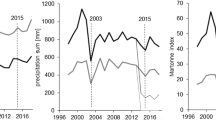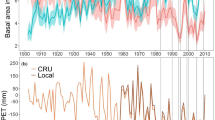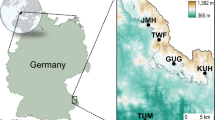Abstract
European beech (Fagus sylvatica L.) is one of the economically most important broadleaved tree species in Central Europe. However, beech shows high drought sensitivity and calls for profound research to test its ability to cope with limited water resources. Here, we investigated the drought tolerance of beech to the 2003 drought as influenced by Kraft class, aspect and thinning intensity. Annual basal area increment data of 126 sample trees from southwest Germany were used to assess the variability of drought tolerance indices, by comparing three social classes (predominant, dominant and co-dominant), two contrasting sites [a dry southwest (SW) aspect and a moist northeast (NE) aspect], and three treatments [control, strong thinning (stand basal area 15 m2 ha−1) and very strong thinning (stand basal area 10 m2 ha−1)] in mature beech stands. Our results show that the co-dominant and dominant trees had lower growth recovery and lower growth resilience after the drought, compared to the predominant trees. The differences between aspects pointed to a growth–drought tolerance trade-off, in which trees on the SW aspect displayed lower growth rates but higher resilience indices than trees on the moist NE aspect. Furthermore, our results suggest that the resistance to and resilience after the 2003 drought significantly increased for the thinned trees. Our results provide novel insights into the linkage between the forest stand management and drought tolerance of beech under contrasting sites. We conclude that thinning can partially alleviate effects of severe drought on European beech forests in southwest Germany and can be applied as an adaptive measure to increase the mitigation potential of beech stands.



Similar content being viewed by others
References
Ammer C, Albrecht L, Borchert H, Brosinger F, Dittmar C, Elling W, Ewald J, Felbermeier B, gilsa H von, Huss J, kenk G, Kölling C, Kohnle U, Meyer P, Mosandl R, Moosmayer HU, Palmer S, Reif A, Rehfuess KE, Stimm B (2005) Zur Zukunft der Buche (Fagus sylvatica L.) in Mitteleuropa: Kritische Anmerkungen zu einem Beitrag von RENNENBERG et al. (2004). Allgemeine Forst- und Jagd Zeitung 176:60–67
Anderegg WRL, Plavcova L, Anderegg LDL, Hacke UG, Berry JA, Field CB (2013) Drought’s legacy: multiyear hydraulic deterioration underlies widespread aspen forest die-off and portends increased future risk. Glob Change Biol 19(4):1188–1196. doi:10.1111/gcb.12100
Assmann E (1970) The principles of forest yield study. Pergamon Press, Oxford
Bates DM (2010) lme4: Mixed-effects modeling with R. Springer, Madison
Bohn U, Gollub G, Hettwer C, Weber H, Neuhäuslová Z, Raus T, Schlüter H (2003) Map of the natural vegetation of Europe—Scale 1:2 500 000, map and explanatory text. Landwirtschaftsverlag, Münster
Bosela M, Štefančík I, Petráš R, Vacek S (2016) The effects of climate warming on the growth of European beech forests depend critically on thinning strategy and site productivity. Agric For Meteorol 222:21–31. doi:10.1016/j.agrformet.2016.03.005
Breda N, Granier A, Aussenac G (1995) Effects of thinning on soil and tree water relations, transpiration and growth in an oak forest (Quercus petraea (Matt.) Liebl.). Tree Physiol 15:295–306
Bunn A, Korpela M, Biondi F, Campelo F, Mérian P, Qeadan F, Zang C (2015) dplR: dendrochronology program library in R. R package version 1.6.3
Cescatti A, Piutti E (1998) Silvicultural alternatives, competition regime and sensitivity to climate in a European beech forest. For Ecol Manage 102(2–3):213–223. doi:10.1016/S0378-1127(97)00163-1
Christensen JH, Hewitson B, Busuioc A, Chen A, Gao X, Held I, Jones R, Kolli RK, Kwon WT, Laprise R, Magaña Rueda V, Mearns L, Menéndez CG, Räisänen J, Rinke A, Sarr A, Whetton P (eds) (2007) The physical science basis. Contribution of working group I to the fourth assessment report of the intergovernmental panel on climate change. Cambridge University Press, New York
Diaconu D, Kahle H-P, Spiecker H (2015) Tree- and stand-level thinning effects on growth of European beech (Fagus sylvatica L.) on a northeast- and a southwest-facing slope in southwest Germany. Forests 6(9):3256–3277. doi:10.3390/f6093256
Diaconu D, Stangler DF, Kahle H-P, Spiecker H (2016a) Vessel plasticity of European beech in response to thinning and aspect. Tree Physiol. doi:10.1093/treephys/tpw053
Diaconu D, Wassenberg M, Spiecker H (2016b) Variability of European beech wood density as influenced by interactions between tree-ring growth and aspect. For Ecosyst 3(6):1–9. doi:10.1186/s40663-016-0065-8
Dittmar C, Zech W, Elling W (2003) Growth variations of Common beech (Fagus sylvatica L.) under different climatic and environmental conditions in Europe—a dendroecological study. For Ecol Manage 173(1–3):63–78. doi:10.1016/S0378-1127(01)00816-7
Eilmann B, Sterck F, Wegner L, de Vries SMG, von Arx G, Mohren GMJ, den Ouden J, Sass-Klaassen U (2014) Wood structural differences between northern and southern beech provenances growing at a moderate site. Tree Physiol 34(8):882–893. doi:10.1093/treephys/tpu069
Elkin C, Giuggiola A, Rigling A, Bugmann H (2015) Short and longterm efficacy of forest thinning to mitigate drought impacts in mountain forests in the European Alps. Ecol Appl 25(4):1083–1098
Ellenberg H (1996) Vegetation Mitteleuropas mit den Alpen in ökologischer, dynamischer und historischer Sicht: 170 Tabellen, 5., stark veränd. und verb. Aufl. UTB, vol 8104. Ulmer, Stuttgart
Fotelli MN, Rennenberg H, Geßler A (2002) Effects of drought on the competitive interference of an early successional species (Rubus fruticosus) on Fagus sylvatica L. seedlings: 15 N uptake and partitioning, responses of amino acids and other N compounds. Plant Biol 4(3):311–320. doi:10.1055/s-2002-32334
Gessler A, Schrempp S, Matzarakis A, Mayer H, Rennenberg H, Adams MA (2001) Radiation modifies the effect of water availability on the carbon isotope composition of beech (Fagus sylvatica). New Phytol 150(3):653–664. doi:10.1046/j.1469-8137.2001.00136.x
Geßler A, Jung K, Gasche R, Papen H, Heidenfelder A, Börner E, Metzler B, Augustin S, Hildebrand E, Rennenberg H (2005) Climate and forest management influence nitrogen balance of European beech forests: microbial N transformations and inorganic N net uptake capacity of mycorrhizal roots. Eur J Forest Res 124(2):95–111. doi:10.1007/s10342-005-0055-9
Geßler A, Keitel C, Kreuzwieser J, Matyssek R, Seiler W, Rennenberg H (2007) Potential risks for European beech (Fagus sylvatica L.) in a changing climate. Trees 21(1):1–11. doi:10.1007/s00468-006-0107-x
Hacke U, Sperry J (2001) Functional and ecological xylem anatomy. Perspect Plant Ecol Evol Syst 4(2):97–115. doi:10.1078/1433-8319-00017
Hacke U, Sperry JS, Pockman WT, Davis SD, McCulloh KA (2001) Trends in wood density and structure are linked to prevention of xylem implosion by negative pressure. Oecologia 126(4):457–461. doi:10.1007/s004420100628
Hauser S (2003) Dynamik hochaufgelöster radialer Schaftveränderungen und des Dickenwachstums bei Buchen (Fagus sylvatica L.) der Schwäbischen Alb unter dem Einfluss von Witterung und Bewirtschaftung, Albert-Ludwigs-Universität Freiburg
Hildebrand E, Augustin S, Schack-Kirchner H (1998) Bodenkundliche Charakterisierung der Kernflächen. In: Rennenberg H (ed) Buchendominierte Laubwälder unter dem Einfluß von Klima und Bewirtschaftung: Ökologische, waldbauliche und sozialwissenschaftliche Analysen—Vorcharakterisierung der Untersuchungsflächen. Eigenverlag der Universität Freiburg, Freiburg, pp 7–12
Hothorn T, Bretz F, Westfall P (2008) Simultaneous inference in general parametric models. Biom J 50(3):346–363
Kohler M, Sohn J, Nägele G, Bauhus J (2010) Can drought tolerance of Norway spruce (Picea abies (L.) Karst.) be increased through thinning? Eur J Forest Res 129(6):1109–1118. doi:10.1007/s10342-010-0397-9
Kraft G (1884) Beiträge zur Lehre von den Durchforstungen. Schlagstellungen und Lichtungshieben. Klindworth’s Verlag, Hannover
Kuznetsova A, Brockhoff PB, Christensen R (2014) lmerTest: Tests in Linear Mixed Effects Models. R package version 2.0-29
Le Goff N, Ottorini J-M (1993) Thinning and climate effects on growth of beech (Fagus sylvatica L.) in experimental stands. For Ecol Manage 62:1–14
Lenth R, Herve M (2015) lsmeans: least-squares means. R package version 2.18
Lloret F, Keeling EG, Sala A (2011) Components of tree resilience: effects of successive low-growth episodes in old ponderosa pine forests. Oikos 120(12):1909–1920. doi:10.1111/j.1600-0706.2011.19372.x
Metz J, Annighöfer P, Schall P, Zimmermann J, Kahl T, Schulze E-D, Ammer C (2015) Site adapted admixed tree species reduce drought susceptibility of mature European beech. Glob Change Biol. doi:10.1111/gcb.13113
Montwé D, Isaac-Renton M, Hamann A, Spiecker H (2015a) Drought tolerance and growth in populations of a wide-ranging tree species indicate climate change risks for the boreal north. Glob Change Biol. doi:10.1111/gcb.13123
Montwé D, Spiecker H, Hamann A (2015b) Five decades of growth in a genetic field trial of Douglas-fir reveal trade-offs between productivity and drought tolerance. Tree Genet Genomes 11(2):1–11. doi:10.1007/s11295-015-0854-1
Poorter L, McDonald I, Alarcón A, Fichtler E, Licona J-C, Peña-Claros M, Sterck F, Villegas Z, Sass-Klaassen U (2010) The importance of wood traits and hydraulic conductance for the performance and life history strategies of 42 rainforest tree species. New Phytol 185(2):481–492. doi:10.1111/j.1469-8137.2009.03092.x
Pretzsch H (2010) Forest dynamics, growth and yield. Springer, Berlin
Pretzsch H, Biber P (2010) Size-symmetric versus size-asymmetric competition and growth partitioning among trees in forest stands along an ecological gradient in central Europe. Can J For Res 40(2):370–384. doi:10.1139/X09-195
Pretzsch H, Schütze G, Uhl E (2013) Resistance of European tree species to drought stress in mixed versus pure forests: evidence of stress release by inter-specific facilitation. Plant Biol 15(3):483–495. doi:10.1111/j.1438-8677.2012.00670.x
R Development Core Team (2016) R: a language and environment for statistical computing. R Foundation for Statistical Computing, Vienna. https://www.R-project.org/
Rennenberg H, Seiler W, Matyssek R, Geßler A, Kreuzwieser J (2004) Die Buche (Fagus sylvatica L.) ein Waldbaum ohne Zukunft im südlichen Mitteleuropa? AFJZ 175:210–244
Sohn JA, Saha S, Bauhus J (2016) Potential of forest thinning to mitigate drought stress: a meta-analysis. For Ecol Manage 380:261–273. doi:10.1016/j.foreco.2016.07.046
Spiecker H (1991) Controlling the diameter growth and the natural pruning of Sessile and Pedunculate oaks. Habilitation. Selbstverlag der Landesforstverwaltung Baden-Württemberg, Stuttgart
Spiecker H, Tilman E, Park Y, Hansen J, Schinker MG, Döll W (2000) Cell structure in tree rings: novel methods for preparation and image analysis of large cross sections. IAWA J 21(3):361–373. doi:10.1163/22941932-90000253
Teskey R, Wertin T, Bauweraerts I, Ameye M, McGuire MA, Steppe K (2015) Responses of tree species to heat waves and extreme heat events. Plant, Cell Environ 38(9):1699–1712. doi:10.1111/pce.12417
van der Maaten E (2012a) Climate sensitivity of radial growth in European beech (Fagus sylvatica L.) at different aspects in southwestern Germany. Trees 26(3):777–788. doi:10.1007/s00468-011-0645-8
van der Maaten E (2012b) Intra- and interannual growth responses of European beech (Fagus sylvativa L.) to climate, aspect and thinning in the Swabian Alb - southwestern Germany. Dissertation, Albert-Ludwigs-Universität Freiburg
Whitehead D, Jarvis PG, Waring RH (1984) Stomatal conductance, transpiration, and resistance to water uptake in a Pinussylvestris spacing experiment. Can J For Res 14(5):692–700
Wickham H (2007) Reshaping data with the reshape package. J Stat Softw 21:1–20
Wickham H (2009) Ggplot2. Elegant graphics for data analysis. Use R!. Springer, Dordrecht
Wickham H (2011) The split-apply-combine strategy for data analysis. J Stat Softw 40(1):1–29
Wickham H (2016) Tidyr: easily tidy data with ‘spread()’ and ‘gather()’ functions. R package version 0.4.1. https://CRAN.R-project.org/package=tidyr
Zang C, Hartl-Meier C, Dittmar C, Rothe A, Menzel A (2014) Patterns of drought tolerance in major European temperate forest trees: climatic drivers and levels of variability. Glob Change Biol 20(12):3767–3779. doi:10.1111/gcb.12637
Acknowledgments
This study used material from the collaborative research project SFB 433 (“Buchendominierte Laubwälder unter dem Einfluß von Klima und Bewirtschaftung: Ökologische, waldbauliche und sozialwissenschaftliche Analysen”-Beech-dominated deciduous forests under the influence of climate and forest management). D.D. is funded by the project BuKlim within the Waldklimafonds program of BMEL/BMUB—“Gefördert durch Bundesministerium für Ernährung und Landwirtschaft und das Bundesministerium für Umwelt, Naturschutz, Bau und Reaktorsicherheit aufgrund eines Beschlusses des Deutschen Bundestages” (28W-C-4-052-01). Two anonymous reviewers helped to improve an earlier version of this manuscript.
Author information
Authors and Affiliations
Corresponding author
Ethics declarations
Conflict of interest
None.
Additional information
Handling Editor: Miren del Rio.
Electronic supplementary material
Below is the link to the electronic supplementary material.
Rights and permissions
About this article
Cite this article
Diaconu, D., Kahle, HP. & Spiecker, H. Thinning increases drought tolerance of European beech: a case study on two forested slopes on opposite sides of a valley. Eur J Forest Res 136, 319–328 (2017). https://doi.org/10.1007/s10342-017-1033-8
Received:
Revised:
Accepted:
Published:
Issue Date:
DOI: https://doi.org/10.1007/s10342-017-1033-8




